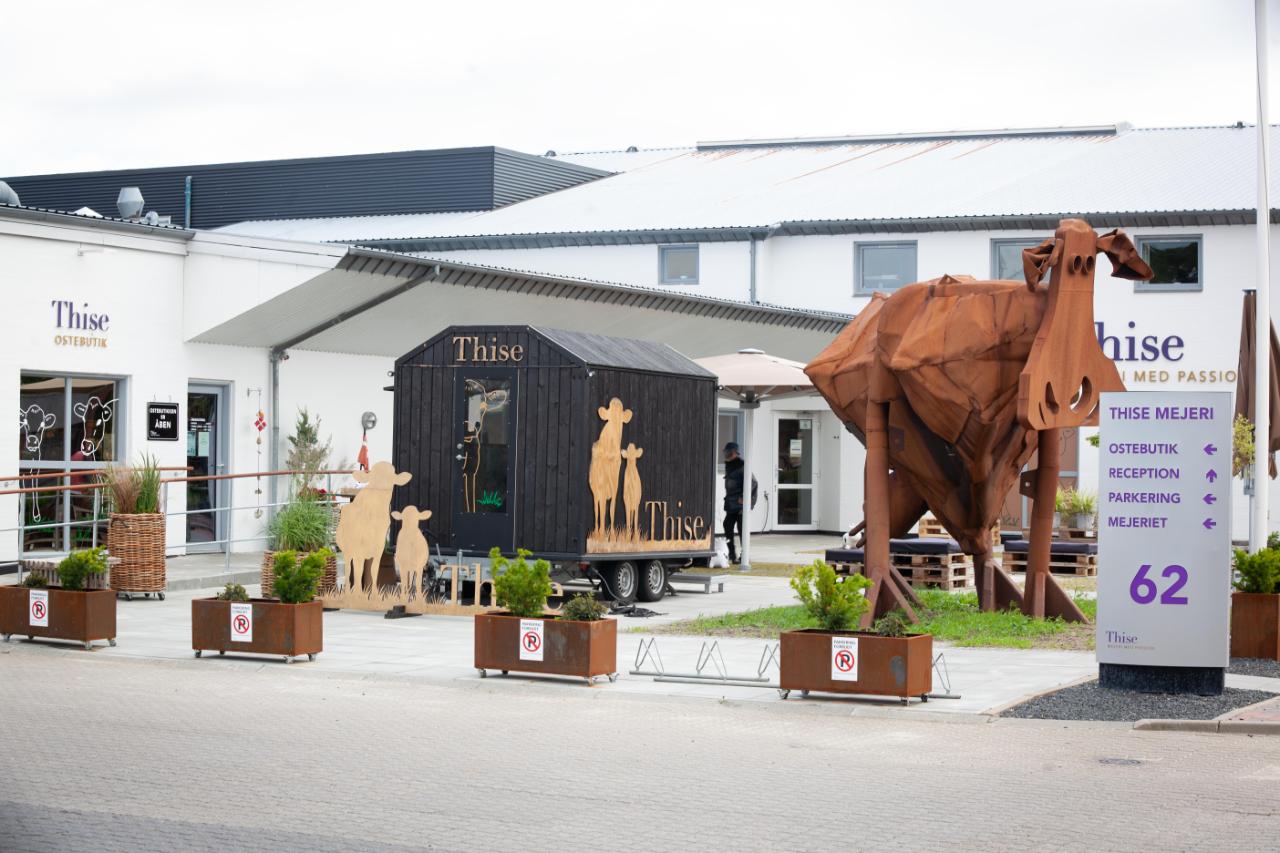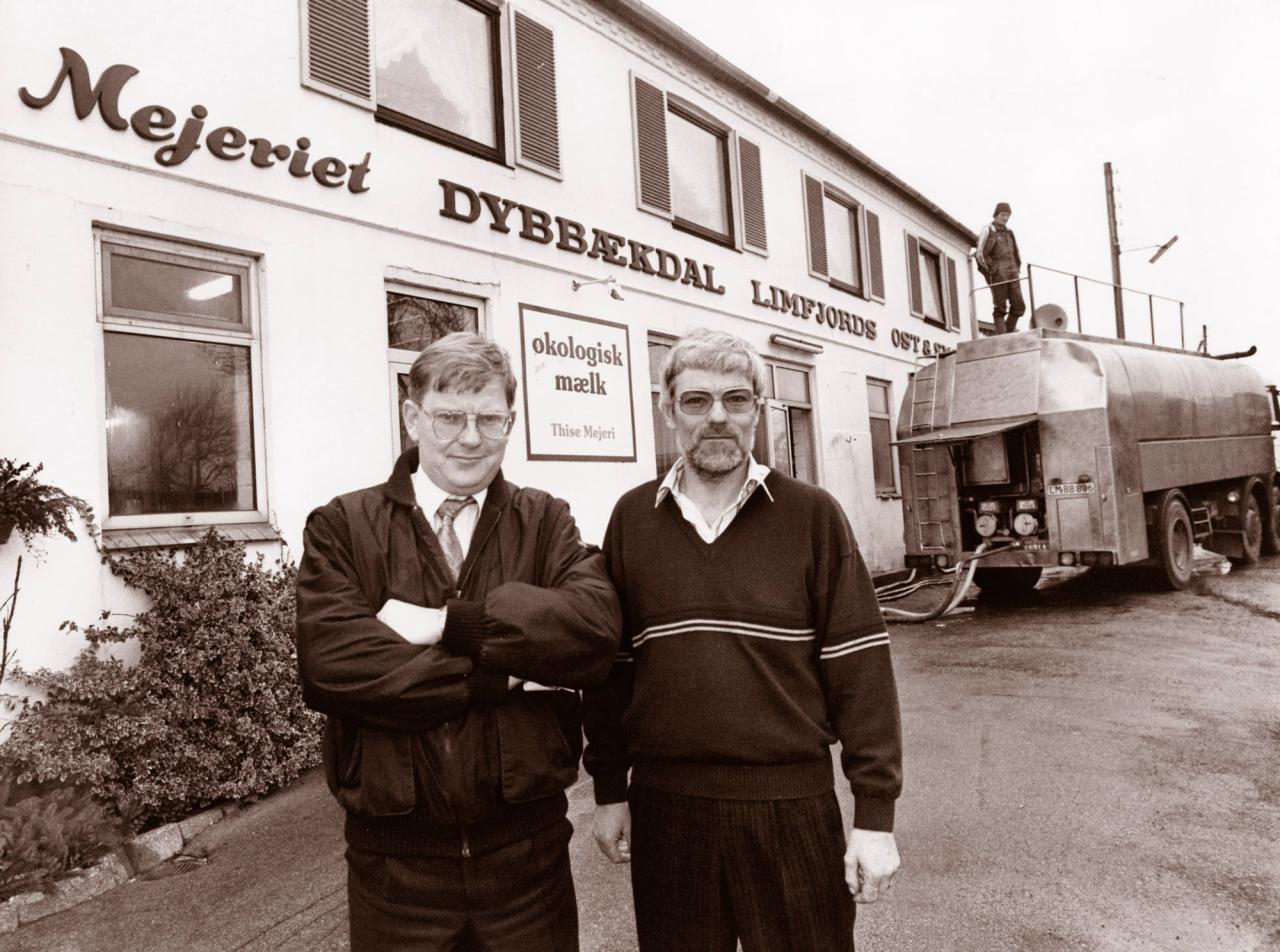
The story of Thise Mejeri is many stories
It is the story of some singularly stubborn milk producers from north and central Jutland who clung on to a dream of providing organic milk and dairy produce to consumers – despite overwhelming opposition in the early years
Virtually no stores wanted the organic produce on their shelves and the dairy recorded a resounding deficit, pushing the dairy farmers’ own finances to the limit.
It is also the story of a small cooperative dairy in Salling that entered into a partnership with the high-end Copenhagen chain Irma in the mid-1990s. Despite obvious differences in culture and mentality – or perhaps because of them – creative sparks flew, resulting in a veritable wave of new products and creative concepts, which firmly planted Thise in consumers’ minds in the following 10 years.
Finally, it is the story of a small village dairy which, over the course of a few decades, grew to the size of a group, with a billion-kroner turnover and exports to faraway regions including the Middle East and China – without losing its village roots.
1980s
1987
Pre-history/prologue
In 1987, a small group of organic dairy farmers from the Thy, Herning and Salling area in north-west Jutland form a producers’ association with the aim of finding a dairy that will turn their milk into organic dairy produce. It proves to be something of an uphill struggle. The organic produce segment is still relatively new and exotic at the time, and none of the major dairy companies want to commit to a new and different product range.
At the end of the year, the group contacts dairyman Peter E. Pedersen who, together with his wife Anna, owns the Mejeriet Dybbækdal dairy in the village of Thise. Pedersen, who is then 66, can see the potential in organic milk.
“It could well be something worth working with,” as he puts it at the first meeting with the group of milk producers.
1980s
1988
In the first few weeks, around 100 litres of milk a week are sold
Peter E. Pedersen and organic milk producers negotiate an agreement: Mejeriet Dybbækdal weighs, processes and taps the organic milk for a fee, while the producers’ association takes care of the distribution and marketing of the milk. Initially, two organic products are to be produced: whole milk and soured milk (tykmælk) – unhomogenised to process the product as gently as possible.
The producers’ association is converted into a cooperative named Thise Mejeri A.m.b.a., and on 2 September, it is ready to tap the first cartons of organic milk with the dairy’s name on them.
There is a great deal of enthusiasm among its members, dairymen and guests, but the joy is short-lived, soon turning into despair: It is virtually impossible to sell the milk. There is zero local interest in organics, and here and elsewhere in Denmark, the stores are often bound by chain agreements with the major dairies.
1980s
1989
The lack of sales places both the new company under immense financial pressure
The cooperative manages to sell a certain amount of products to smaller wholesalers and distributors. However, most of the milk still cannot be sold as organic produce, but is sold to Mejeriet Dybbækdal, which uses it for conventional products.
The lack of sales places both the new company and the cooperative members under immense financial pressure. Several of the dairy farmers are experiencing increasing pressure from their worried banks, wondering how long they intend to continue with the whole organic thing.
But they refuse to give up. For example, one of the members’ wives drives around to every grocer in Thy and offers them a free crate of milk if they will try putting organic produce from Thise Mejeri on their shelves.
1990s
1990
The dairy’s total deficit for the first 25 months passes the DKK 1 million mark
Along with the Grindsted Mejeri and Naturmælk organic dairies, Thise Mejeri joins a joint marketing company named Dansk Naturmælk. This opens up the possibility of receiving a grant from the then Danish Ministry of Agriculture for investments – a welcome help for the ailing Thise Mejeri.
However, the big breakthrough comes when Dansk Naturmælk and the company Kløvermælk conclude a contract with FDB (now COOP) to supply milk to the chain’s stores under the DanMælk label, which up to that point has been the preserve of MD Foods.
The agreement means that, at a stroke, Thise Mejeri can sell half of its milk as organic – the largest share in the dairy’s history.
1990s
1992
Peter E. Pedersen sells Mejeriet Dybbækdal
Peter E. Pedersen sells Mejeriet Dybbækdal to his son Poul J. Pedersen and his colleague Erik Ellebæk.
The new owners continue to work with Thise Mejeri, where they soon face new challenges: That same year, the DanMælk agreement with FDB expires, and Dansk Naturmælk closes shortly thereafter.
After a couple of years of relatively stable sales, the small dairy is again looking for new distributors.
1990s
1993
Thise Mejeri starts supplying Danbo cheeses to FDB
That same year, FDB launches a major campaign for organic foods in its 300 SuperBrugsen stores. Sales of the products bearing the Danish eco-label (the Ø-mark) rise sharply – and, unlike before – consumer interest does not drop off again at the end of the campaign. On the contrary, demand continues to rise, giving the small organic dairy in Thise renewed hope.
1990s
1994
The Danish appetite for organic dairy produce continues to grow
The Danish appetite for organic dairy produce continues to grow. At one point, it reaches a level where the dairies cannot keep up with demand.
For the first time in the dairy’s history, Thise Mejeri is able to sell half of its full quota of organic milk as organic dairy produce.
1990s
1995
A full range of organic fermented milk products
Thise Mejeri concludes a five-year trade agreement with FDB, with the aim of developing a full range of organic fermented milk products, among other things.
That same year, Thise Mejeri signs an agreement with FDB’s Irma chain for the sale of organic drinking milk.
1990s
1996
Sales of organic dairy produce reach new heights
Thise Mejeri and Mejeriet Dybbækdal form a joint production company for the two dairies.
Sales of organic dairy produce reach new heights, with 14,000 litres of drinking milk being sent to the Irma chain’s stores every day. To keep up with demand, Thise Mejeri has to buy in milk from Grindsted Mejeri in northern Jutland, and the fledgling dairy Øllingegaard Mejeri in north Zealand.
The dairy now has 39 members and an annual total production of 9 million kilos.
1990s
1997
Thise Mejeri merges with Grindsted Mejeri
Thise Mejeri merges with Grindsted Mejeri, which is having trouble paying its suppliers a competitive price. The merger significantly increases the dairy’s total production, product range and number of members. In addition, Thise Mejeri takes over a cooperation agreement with the small Gedsted Mejeri, which produces organic blue cheeses.
And last but not least, Grindsted Mejeriet’s sales manager Mogens Poulsen moves to Thise Mejeri, where, over the coming years, he cooperates closely and highly productively with head dairyman Poul J. Pedersen on product development and marketing, significantly boosting the dairy’s profile in the media and consumer awareness.
00s
2001
Thise Mejeri develops a low-fat milk with a rich flavour
At the request of Irma director Alfred Josefsen, Thise Mejeri develops a low-fat milk with a rich flavour: a Jersey skimmed milk with 0.5 per cent fat. (At this time, all other skimmed milk on the market contains 0.1 per cent fat). The new milk is a kind of precursor to “Minimælk” (milk, skimmed, 0.5% fat), which will soon come to dominate the Danish milk market.
For Thise and Irma, this also marks the start of the development of a brand new range of different types of Jersey milk.
But it doesn’t stop there. Over a number of years, Thise and Irma develop a close and unique partnership, allowing them to develop and launch a stream of new products and concepts at very short notice. “The perfect match” is one of the headlines written about the almost symbiotic collaboration between the two companies.
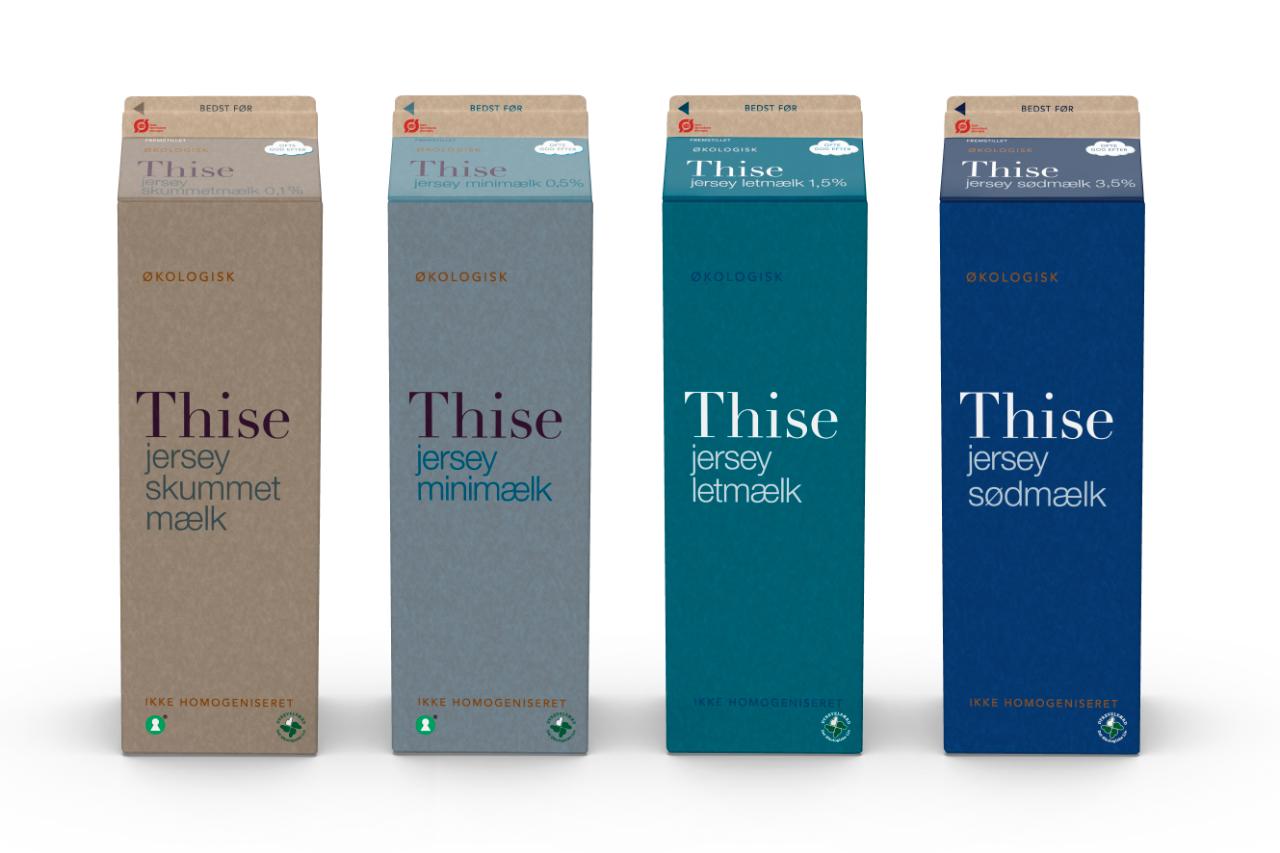
00s
2002
Thise Mejeri receives the Danish Dairy Board’s concept award
At the annual Landsmejeriudstilling (Scandinavian Dairy Contest) in Herning, Thise Mejeri receives the Danish Dairy Board’s concept award for the development of its Jersey range.
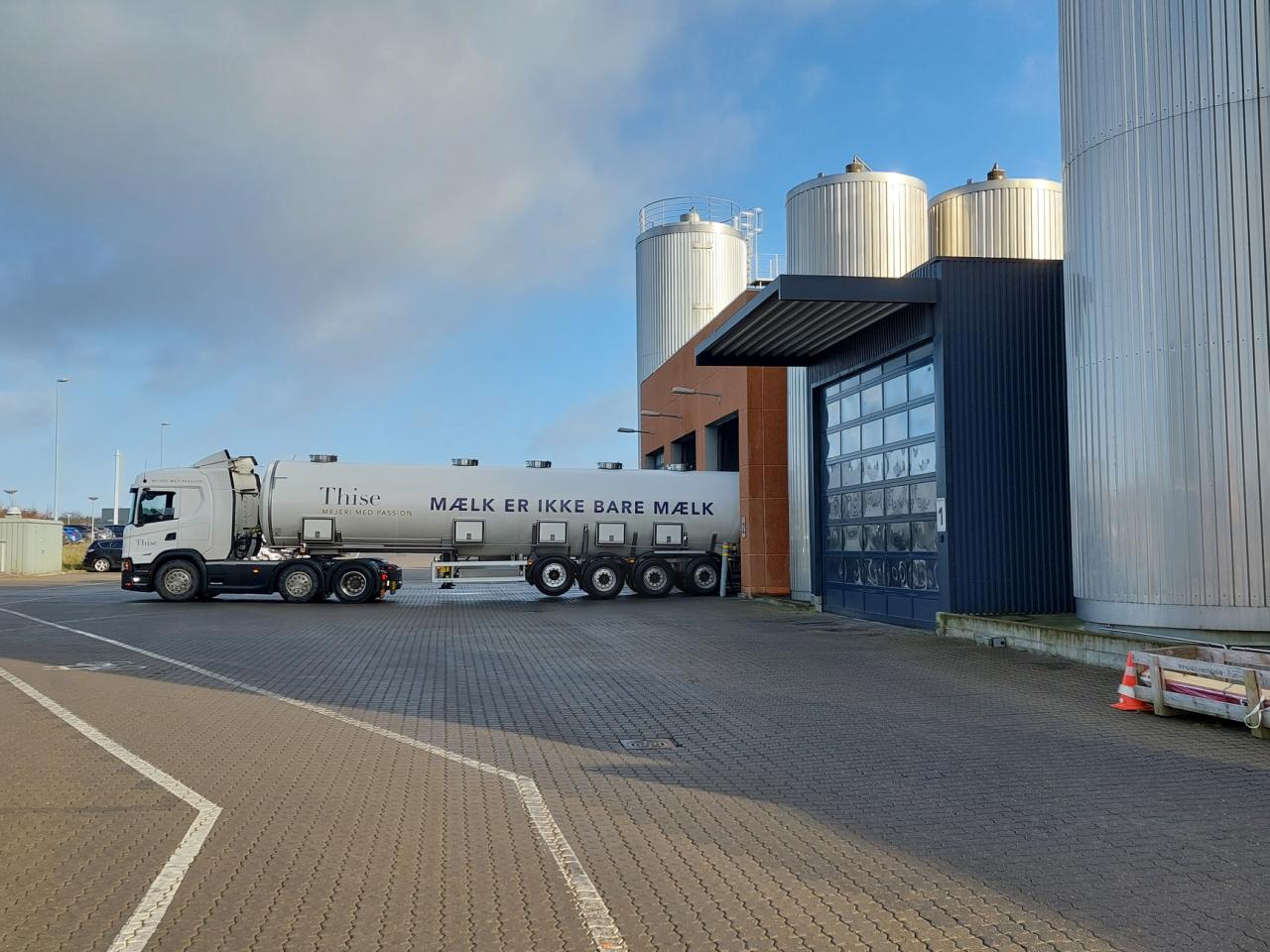
00s
2003
The Danish competition authorities versus Arla Foods
The Danish competition authorities open proceedings against the country’s largest dairy, Arla Foods. In the wake of the negative publicity generated by the case, consumer interest in products from the smaller dairies increases. This is very much felt at Thise Mejeri, which struggles to keep up with the surging demand.
00s
2004
Thise Mejeri is suspected of being the source of the E. coli 0157 bacterium
One Friday in March, a representative of the Danish Veterinary and Food Administration visits, bearing some shocking news: 28 people in the Copenhagen area have fallen ill from the dreaded E. coli 0157 bacterium within the past year, and Thise Mejeri is suspected of being the source.
The Danish Veterinary and Food Administration demands that production be shut down and that the dairy’s fresh milk products are removed from all stores in the country. Over the next few days, the production apparatus is checked intensively for E. coli 0157. However, none is found, and on the Sunday, the dairy is allowed to resume production.
Nevertheless, the dairy has to endure a nerve-racking wait of up to three weeks for the results of hundreds of laboratory analyses to trickle in. None of the analyses show signs of the bacterium.
Concerns that the dairy’s image has taken an irreparable blow also prove to be unfounded. In fact, sales of dairy products from Thise Mejeri actually increase by 10 per cent immediately afterwards.
00s
2005
Thise milk can now be purchased all over Denmark
The agreement with COOP (formerly FDB) is extended to include all of the chain’s stores, including Fakta. For the first time ever, Thise milk can now be purchased all over Denmark.
00s
2006
The first sod is cut for the construction of a large new dairy plant
The sharp increase in sales of the previous years forces Thise Mejeri to expand its production capacity. The tapping machines cannot keep up, and there is a serious lack of space in the production halls and in the chiller room.
Under licence from the Icelandic dairy company MS Agrice, Thise Mejeri tries its hand at producing the classic Icelandic fermented milk product, skyr. The presentation of the protein-rich product takes place at Noma in Copenhagen, the restaurant where the young chef René Redzepi serves delicacies made from skyr. The Icelandic Minister of Agriculture and the Danish Minister for Environment and Food toast the Nordic cooperation between the two dairies. However, consumer enthusiasm for skyr is less forthcoming. It will take three years for the product to really take off.
[LH1]NB. Spelt incorrectly in the DK source
00s
2007
Grindsted Mejeri closes
The dairy in Thise takes over the production of white mould cheese.
Thise Mejeri takes over a property with cheese storage facilities at Bovbjerg Fyr lighthouse, south of Thyborøn.
That same year, Thise Mejeri assumes full ownership of the dairy in Thise, and Mejeriet Dybbækdal rents premises at Thise Mejeri. The owner/tenant roles are now completely reversed between the two dairies, compared to when Thise Mejeri started out at Mejeriet Dybbækdal in 1988.
00s
2008
A hard, extra mature “continental” cheese, inspired by Dutch cheese
Since acquiring the property at Bovbjerg Fyr, the dairy’s cheese makers have been working on the development of a new cheese to be stored in the salty North Sea air. The result is a hard, extra mature “continental” cheese, inspired by Dutch cheese. The raw milk comes from seven members in the area around Bovbjerg. The new cheese is named “Vesterhavsosten” (North Sea cheese), and soon after its launch, it is awarded the Danish dairy industry’s gourmet award, “Mejeribrugets Gourmetpris”.
On 1 September, the new, high-tech dairy plant is inaugurated: An extension of 9,000 m2, which, among other things, houses two palletising robots, four fully automatic tapping lines, five new cheese vats, a new skimming hall, new weighing, cold storage, etc. Price: DKK 210 million.
After a sales growth of up to 30 per cent per year since 2004, the financial crisis hits Thise Mejeri. For the first time in more than 10 years, the dairy again finds itself with a surplus of milk. Thise therefore sets up a subsidiary, Vechtenaer BV, in the Netherlands to sell significant quantities of surplus milk to a Dutch eco-dairy, as well as to start up the sale of Thise products in the Benelux countries.
00s
2009-2011
the low-fat, protein-rich product becomes de rigueur among a broad section of the Danish population
Sales of skyr, which up to that point has been one of the chiller cabinet’s most overlooked niche products, suddenly begin to take off. Thanks to a health trend, the low-fat, protein-rich product becomes de rigueur among a broad section of the Danish population. Other dairies begin to produce skyr, and in the years that follow, the product enjoys long, uninterrupted growth, boosting the entire category of fermented products.
10s
2016
Milk intake from Thise farmers: 99 million kilos of milk
Thise Mejeri introduces a complete ban on the culling of Jersey bull calves/ all bull calves born to Thise's cooperative members, even if rearing the bull calves is unprofitable. Only calves that are incurably ill and require veterinary treatment may be culled.
In connection with the ban, Thise, in collaboration with COOP, develops a new pricing model that ensures the economic viability of rearing Jersey bull calves.
Four years later, the new Thise bull standards are introduced to all Danish dairy farmers.
Thise & Co. starts delivering organic beef and veal to COOP. The agreement covers animals born to Thise's cooperative members, and ensures that COOP purchases the entire production of beef and veal.
10s
2017
Milk intake from Thise farmers: 103 million kilos of milk
Launching Grass Milk - Denmark's most expensive type of milk comes from cows that exclusively eat grass and grass products year-round. The milk has a fat content of 4.2% and contains more Omega 3 and 6 fatty acids than other milk types.
Thise's grass milk carries the message that we should eat less meat, fewer dairy products, and much more greens.
In the first full financial year of selling veal and beef to COOP, Thise & Co. lives up to expectations, with COOP purchasing all meat from Thise's cooperative members as well as contract breeders who rear Jersey bull calves born to Thise's cooperative members.
Thise IS - is launched in the Danish market.
Thise's expanded cheese storage facility in Bovbjerg is inaugurated.
10s
2018
Milk intake from Thise farmers: 106 million kilos of milk
The dairy celebrates its 30th anniversary.
Thise's Environmental Award, the "Rav-Åge Prize," is awarded to:
Bjarne Hansen, son of Rav-Åge.
10s
2019
Milk intake from Thise farmers: 107 million kilos of milk
Launching Milk Ad Libitum - the part of the cows' milk that is left for Danish consumers when the calves have drunk what they can. Milk Ad Libitum - milk after the calves' thirst.
Full Moon Cheese wins the Dairy Industry Gourmet Prize - accompanied by fantastic judge comments:
Thise's first CSR report is titled "Integrity".
Denmark's most sustainable food brand (2019/2020/2021/2022).
"World-class cheese art / Something truly special / The kingdom's most beautiful, wild, captivating, and dramatic moldy rind / Nose of ammonia, animal, damp cellar/cave, and fresh mushroom from the rind, and in the mouth nuts, butter, and kitten's sharp acidity as a contrast to the rich fat - a sure winner."

20s
2020
Milk intake from Thise farmers: 112 million kilos of milk
In 2020, new so-called "brown-board" cartons are introduced, which means that the dairy's milk is now packaged in a new climate-friendly carton. The new cartons are based on wood pulp from Scandinavia and ensure a significant reduction in CO2 emissions.
The cardboard in the carton comes from wood pulp from Scandinavian forests and both the outer and inner sides are completely unbleached. Additionally, the plastic membrane on the carton's outer and inner sides, which ensures quality and durability, is based on wood oil extracted from pine trees from Scandinavian forests.
2020 is also the year when our Christmas cheese sees the light of day. The cheese is produced during the Christmas period, specifically from the Winter Solstice, usually on December 21st, until Christmas Day, December 25th.
After salting and coating at Thise Dairy, the Christmas cheese is transported to Hjerm - to Santa's secret cheese storage. The Christmas cheese is a hard cheese, and during the long aging period, a little Christmas miracle happens: the otherwise hard and firm cheese becomes softer, richer, and more malleable - in both texture and taste.
After 10-11 months of loving care and attention, the cheeses are fully matured and ready to be enjoyed and contribute to spreading the Christmas spirit.
Christmas has brought blessed cheese...
On the product side, the first plant-based products are also launched. The products are made, among other things, from oats from Thise's own shareholders.
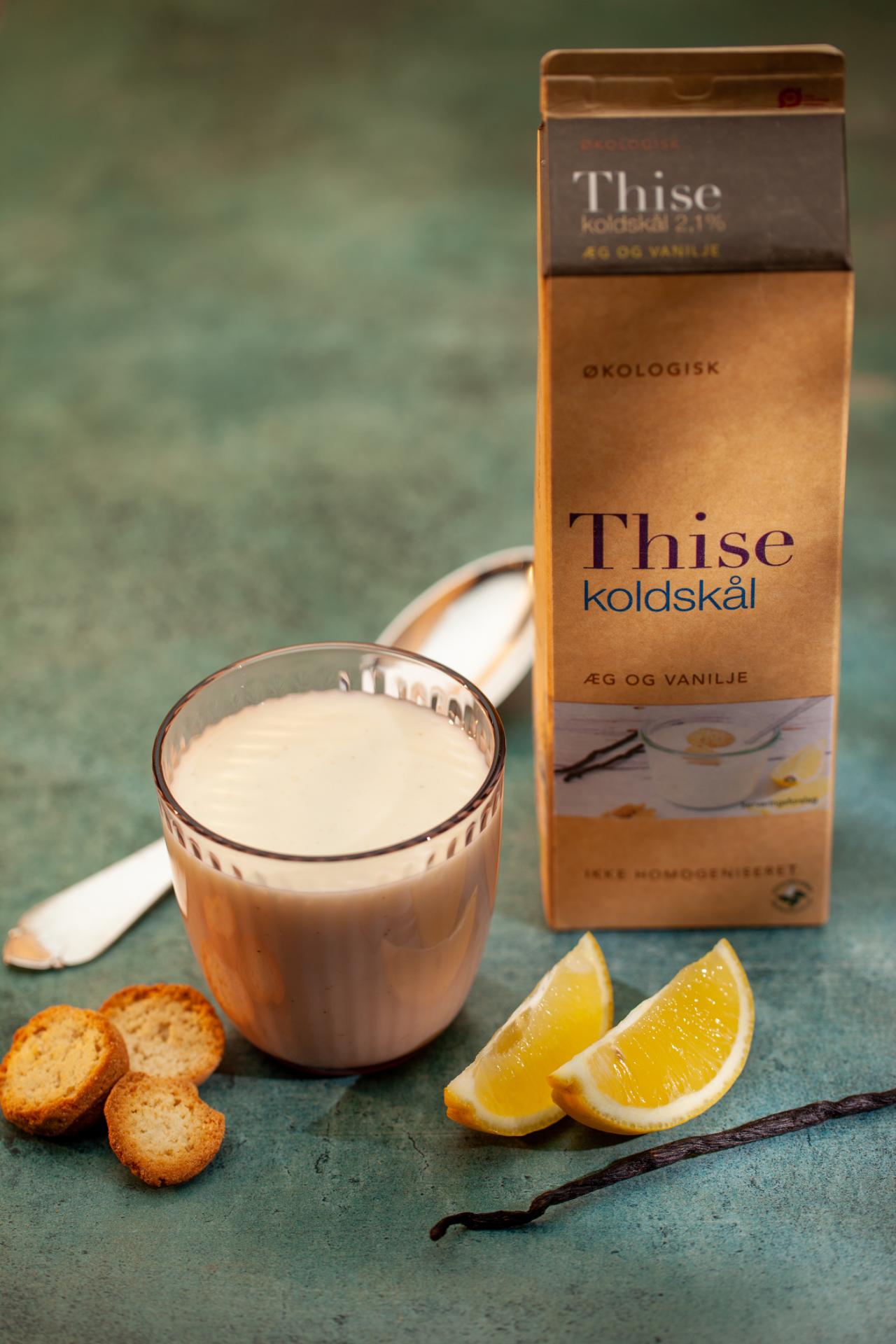
20s
2021
Milk intake from Thise farmers: 120 million kilos of milk
All Thise cows are getting more space. We are making big changes to the production of our dairy products. All cows will have more space in the barn. This means that all of the dairy products - milk, cream, cheese, cultured products, skyr and cheese - produced after August 1st, 2021 meet the requirements for 3 hearts in animal welfare labeling.
In 2021, our Grubelagret Vesterhavsost wins the Dairy Industry Gourmet Prize.
20s
2022
Milk intake from Thise farmers: 126 million kilos of milk
The year is particularly marked by the introduction of a total soy stop for the dairy's shareholders. From October 1, 2022, all of Thise's farmers will stop feeding their cows, young cattle, and calves with soy.
Instead, the animals will be fed with other protein crops such as horse beans, peas, and lupines.
In 2022, we will also continue the fight for more and wilder nature. The goal is to increase biodiversity on each farm by 10% as a starting point. The work has already begun and will continue in the coming years.
In 2022, we will also complete the last extensions to the dairy. This will bring the total area under cover to approximately 22,000 m2. The new buildings include storage and cooling rooms, as well as space for expanding production. Solar panels will also be installed on the roofs of the new buildings, which will cover about 5% of the dairy's electricity consumption.
